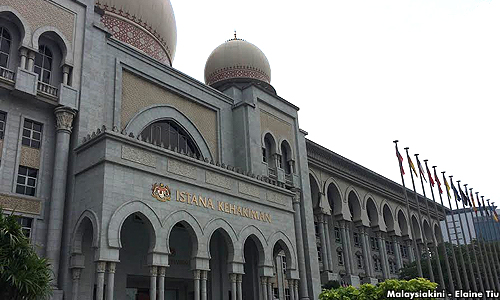This article is in relation to the recent extension of appointment of the current Chief Justice and the President of the Court of Appeal under Article 122(1A) of the Federal Constitution.
First and foremost, names do not matter in this discussion. It is the office of the Chief Justice and the office of the President of the Court of Appeal that are of utmost importance and should always be the point of focus.
Article 122B of the Federal Constitution provides for the appointment of judges to the Federal Court.
For sake of clarity, the office of the Chief Justice of the Federal Court is held by a judge of the Federal Court.
And the office of the President of the Court of Appeal is also held by a judge of the Federal Court AND NOT a by a judge of the Court of Appeal.
Article 125 (1) of the Federal Constitution states that a judge of the Federal Court shall hold office until he attains the age of 66 years or such later time, not being later than six months after he attains that age, as the Yang di-Pertuan Agong may approve.
So, to put it in simple words, a person holding the office of a Federal Court judge is only permitted by the Federal Constitution to do so until that person’s 66th birthday, plus another maximum six months, if approved by the Agong.
At the expiry of that period, the office of a Federal Court judge is deemed by law to be vacant, as far as the Federal Constitution is concerned, because the appointment ceases to have effect.
It is at this juncture that the question of re-appointment of a Federal Court judge comes into play.
And the Federal Constitution does contain the necessary provisions for this re-appointment of a Federal Court Judge after his or her appointment ceases to have effect.
Article 122(1A) of the constitution provides that the Yang di-Pertuan Agong, acting on the advice of the Chief Justice of the Federal Court, may appoint for such purposes, or for such period of time as he may specify, a person who has held high judicial office in Malaysia to be an additional judge of the Federal Court. This additional judge can be over the age of 66 years.
So now, the question that arises is whether a sitting Federal Court judge holding the office of the Chief Justice of the Federal Court be re-appointed as a Federal Court judge to the office of Chief Justice under Article 122(1A) of the Federal Constitution?
Likewise, can a sitting Federal Court Judge holding the office of the President of the Court of Appeal be re-appointed as a Federal Court judge to the office of the President of the Court of Appeal under Article 122(1A) of the Federal Constitution?
While it is clear that the words ‘a person who has held high judicial office’ might be a giveaway to the contention that a current sitting Federal Court judge cannot fall under this appointment, but for now let us put that aside.
Is the answer in Article 124?
Perhaps the answer could be found in Article 124 of the Federal Constitution, which talks about oaths of offices of judges.
Article 124(1) of the Federal Constitution provides that the Chief Justice of the Federal Court shall, before exercising the functions of his office, take and subscribe the oath of office and allegiance in the presence of the Yang di-Pertuan Agong and before any other judge in the presence of the Chief Justice or, in his absence, the next senior judge of the Supreme Court available.
Article 124(4A) of the Federal Constitution provides that a person taking the oath on becoming a judge of the Federal Court shall do so in the presence of the Chief Justice or, in his absence, the next senior judge available of the Federal Court.
We know now that a person appointed as an additional judge of the Federal Court under Article 122(1A) has to eventually take the oath of office of a Federal Court judge under Article 124(4A), and he or she has to do so in the presence of the Chief Justice.
So, for a sitting Chief Justice of the Federal Court, come the date of his or her appointment as an additional judge of the Federal Court after his or her initial tenure expires, how is he or she going to take the oath of office before himself or herself?
One may argue that it could be done in the presence of the next senior judge available at the Federal Court. However, that only applies when the Chief Justice is absent. But the Chief Justice, or rather the awaiting additional judge, is there, waiting to take the oath.
So, logic would dictate that a Chief Justice appointed under Article 122B(1) of the Federal Constitution and an additional judge of the Federal Court appointed under Article 12(1A) of the Federal Constitution cannot simultaneously be the same person.
Ultimately, the only proper way to approach this issue is if a current sitting Chief Justice of the Federal Court sees his or her tenure through, at the expiry of that term let the office of the Chief Justice be filled by another person, and then the retiree be re-appointed as an additional judge of the Federal Court, and then remove the newly-appointed Chief Justice according to Article 125 of the Federal Constitution for whatever reason, and then be appointed as the Chief Justice of the Federal Court, again, under Article 122B(1) of the Federal Constitution.
Anything short of this process would result in a mockery of the Federal Constitution.


